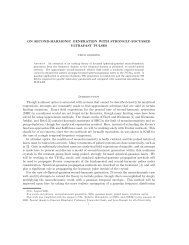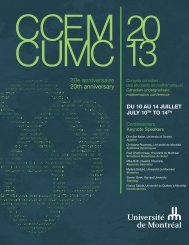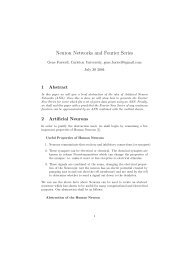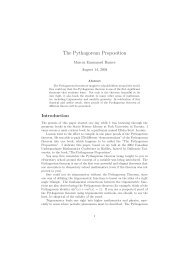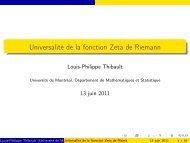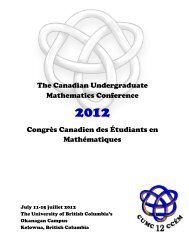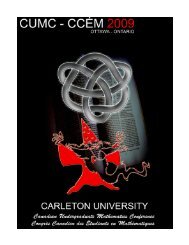booklet - CUMC - Canadian Mathematical Society
booklet - CUMC - Canadian Mathematical Society
booklet - CUMC - Canadian Mathematical Society
You also want an ePaper? Increase the reach of your titles
YUMPU automatically turns print PDFs into web optimized ePapers that Google loves.
to be determined dynamically from an additional boundary condition at the contactline.We will present numerical approximations of solutions to the reduced model derivedfrom Benilov and Vynnycky’s work, and simulate the blow-up behavior underdifferent initial conditions. The numerical results confirm the main claim by Benilovand Vynnycky, that is, for any suitable initial condition, there is a finite positive time atwhich the speed of the contact line becomes infinite. We will also show that the speednear the blow-up is better approximated by a power function of time, compared withthe logarithmic function claimed in Benilov and Vynnycky’s paper.MODELING THE DAMAGE MECHANISM OF COLLAGEN FIBRES WITH HOOKEAN SPRINGSAND GILLESPIE ALGORITHMCHIEH-TING (JIMMY) HSU25 kinds of Collagen proteins are found in various tissue structures such as bone,skin, muscle and tendon in a human body. Understanding the mechanical propertiesof collagen is important for biophysics, biomechanics and bioengineering. ProfessorMichael Lee’s group at Dalhousie University found novel kinked structures in the ScanningElectron Microscope images on the collagen fibrils in steer-tail tendons that werecyclically loaded at a constant strain rate. The stress-strain curve measured during thecycle shows hysteresis loop with the Young’s modulus decreasing over cycles. We havemodeled the kink formation dynamics using the Gillespie algorithm with the kink formationrate depending on the current tension on the fibril, with a simplified elasticmodel of the fibril composed of Hooke-like springs in series. We are able to recoversimilar stress-strain hysteresis curves, consistent with kinks being softer under tensionthan undamaged fibrils.BLOW UP SOLUTIONS TO THE NON-LINEAR SCHRÖDINGER EQUATIONCHRISTOPHER MAHADEOThe non-linear Schrödinger (NLS) equation, iu t = ∆u + gu|u| (p−1) , is an importantpartial differential equation that arises in many physicals contexts. In non-linear optics,it describes the propagation of laser beams in a non-linear medium. A key property ofthe NLS equation is the possible formation of singular solutions. Physically this correspondsto the focusing of the laser beams; mathematically, it is associated to certainnorms of the solution becoming infinite in a finite time.I will first give basic properties of the NLS equation, such as conservation of the L 2norm and of the Hamiltonian. I will then present the proof of the existence of singularsolutions following the paper of R. Glassey [Journal of <strong>Mathematical</strong> Physics, Vol. 18,No. 9, 1977], that there exists a finite time t ∗ such that ∫ ‖u(x, t)‖ 2 dx and sup x‖u(x, t)‖become infinite as t approaches t ∗ .3D PRINTING AND MATHEMATICSCHRISTOPHER OLAHFrom printing fractals to Riemann surfaces, recent increases in the availability of3D printers bring tremendous opportunity for visualizing mathematics. In this talk,21



